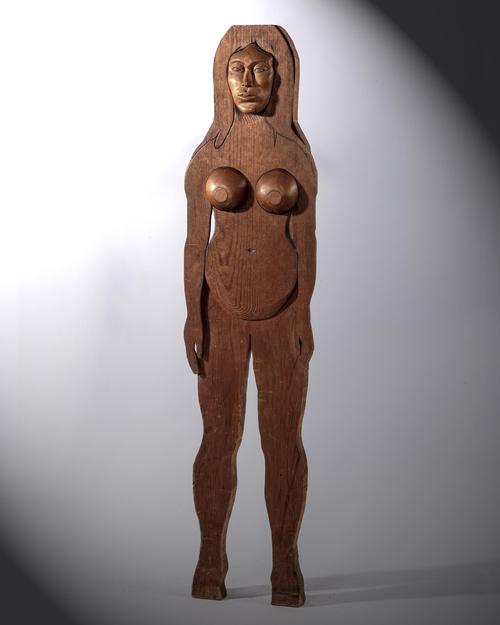"Charles Jarm: Bodies of Work" at Powers / Lowenfels
- NEW YORK, New York
- /
- October 20, 2021


Steven S. Powers | Joshua Lowenfels to exhibit a powerful discovery in figurative self-taught sculpture October 21 - November 21.
In the early 1970s, Charles Jarm (1932 - 2021), a gay Chinese-American, lived in New York City on Mulberry Street, where Little Italy and Chinatown overlap. He was nearly forty years old; inspired, he began carving large wooden figures in his living room. The half-sized and full-sized men and women that he carved and constructed were inventive and ambitious. Photographs from the period document Jarm working naked, chiseling the nude wooden subjects flat on the floor of his apartment. Then this remarkable body of work was shelved and, in a sense, put into a time capsule only to be revealed now.
Unfortunately, we know little of Jarm’s life. He was born eleventh of fifteen children to Chinese immigrant parents who moved from Ohio to New York City’s Chinatown to open a laundromat. It is unknown if he had any art instruction. Each figure’s atypical and inconsistent construction makes us believe that Jarm was self-taught in this creative endeavor.
The figures are imposing, confident, and unlike any other figurative works that come to mind. Constructed of lumber-store bought thick pine boards, Jarm carved the figures in shallow relief and sandwiched boards to fill them out and aid in creating hidden joints where limbs are attached. The bodies are further defined with graphite to strengthen and add volume to flat details. Each figure is distinct and likely portraits of friends.
Jarm’s body of work is singular and hard to put into a “school,” though the documentation of him working naked was very much part of the Fluxus movement around him. The act and performance of creating the work appear integral to the physical work itself. Though we do not know the extent to which Jarm was involved in Fluxus, his name appears in The Gilbert and Lila Silverman Fluxus Collection Archives at MOMA and lived at a Wooster Street Fluxhouse operated by George Maciunas.
Not only did Jarm reside where Chinatown and Little Italy overlap, but his love life also mirrored it. His lifelong partner was an Italian-American named Rocco Sacramone, a music executive with CGC Records. It appears that after these years of mid-life creativity, he had a career in the daycare business and then retired to Palm Springs with his partner, where he stored the work for the last fifty years.

Jarm must have been certain that he created something solid with his inspired “Bodies of Work,” however, due to unknown circumstances, the works were never shown, time and life moved on, and the moment was lost. Timing can be a fickle mistress. Maybe the work was too against the grain, as it were for the time. It was objectively good and unlike any other sculpture around him in the Downtown art scene, which was more abstract and conceptual. In a sense, it was more like the portraits being painted by Chuck Close, but on a more personal scale.
In this “Bodies of Work” exhibition Charles Jarm’s work receives an overdue and worthy posthumous spotlight. The exhibition runs from October 21 - November 21, 2021.
Steven S. Powers | Joshua Lowenfels is located at 53 Stanton Street, New York, NY 10002.
Contact:
Steve PowersSteven S. Powers
917-518-0809
steve@stevenspowers.com













__Night_Shadows__192100x100_c.jpg)


